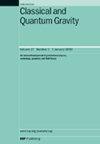变形金刚能否帮助我们对引力波探测器中的重叠信号进行参数估计?
IF 3.7
3区 物理与天体物理
Q2 ASTRONOMY & ASTROPHYSICS
引用次数: 0
摘要
重叠信号是下一代引力波探测器的主要数据分析挑战之一。我们利用变形和归一化流,最先进的机器学习算法,来解决爱因斯坦望远镜(ET)重叠双黑洞合并的参数估计。我们提出的模型结合了基于变压器的“知识提取神经网络”(KENN)和归一化流(HYPERION),对多个重叠的黑洞二元事件进行快速无偏推断。架构的选择利用了transformer在捕获应变时间序列数据中的复杂和长期时间结构方面的优势,而Normalizing Flows为采样后验分布提供了一个强大的框架。我们证明了我们的模型在模拟引力波信号上的有效性和鲁棒性,表明无论数据中的相关水平如何,它都保持相同的精度水平。此外,我们的模型提供了啁啾质量和合并时间的估计,与真实模拟值相差在-20%以内。获得的结果是有希望的,并表明这种方法可能代表了面向ET和其他未来引力波探测器的基于深度学习的推理管道的第一步。本文章由计算机程序翻译,如有差异,请以英文原文为准。
Can Transformers help us perform parameter estimation of overlapping signals in gravitational wave detectors?
Overlapping signals represent one of the major data analysis challenges in next-generation gravitational wave detectors. We leverage Transformers and Normalizing Flows, state-of-the-art machine learning algorithms, to address the parameter estimation of overlapping binary black hole mergers in the Einstein telescope (ET). Our proposed model combines a Transformer-based ‘Knowledge Extractor Neural Network’ (KENN) with a Normalizing Flow (HYPERION) to perform rapid and unbiased inference over multiple overlapping black hole binary events. The choice of architecture leverages the strength of Transformers in capturing complex and long-range temporal structures in the strain time series data, while Normalizing Flows provide a powerful framework to sample posterior distributions. We demonstrate the effectiveness and robustness of our model over simulated gravitational wave signals, showing that it maintains the same level of accuracy regardless of the correlation level in the data. Moreover our model provides estimates of chirp mass and coalescence times within –20% from the true simulated value. The results obtained are promising and show how this approach might represent a first step toward a deep-learning based inference pipeline for ET and other future gravitational wave detectors.
求助全文
通过发布文献求助,成功后即可免费获取论文全文。
去求助
来源期刊

Classical and Quantum Gravity
物理-天文与天体物理
CiteScore
7.00
自引率
8.60%
发文量
301
审稿时长
2-4 weeks
期刊介绍:
Classical and Quantum Gravity is an established journal for physicists, mathematicians and cosmologists in the fields of gravitation and the theory of spacetime. The journal is now the acknowledged world leader in classical relativity and all areas of quantum gravity.
 求助内容:
求助内容: 应助结果提醒方式:
应助结果提醒方式:


